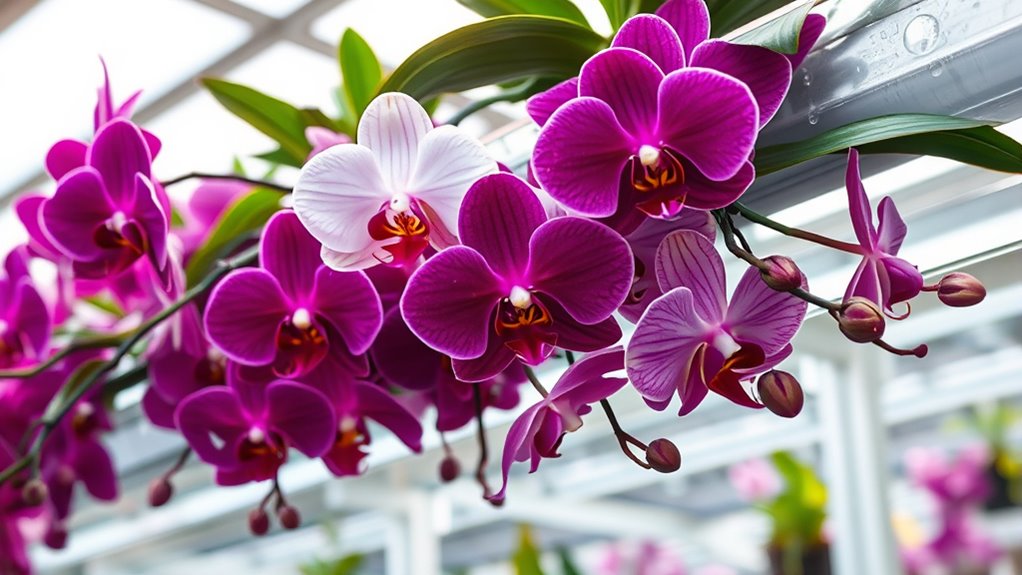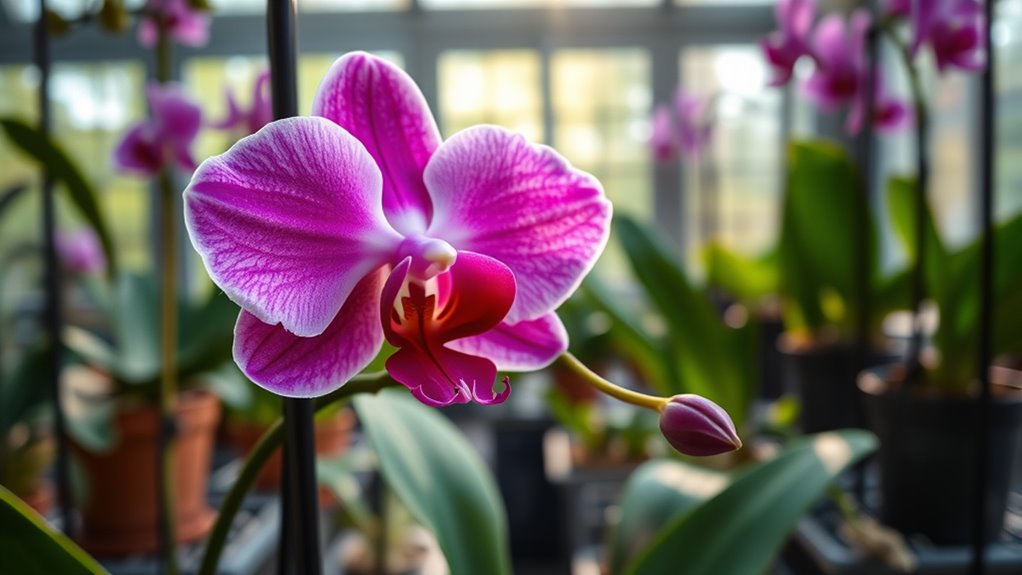To care for orchids in a greenhouse, focus on maintaining stable temperatures between 65°F and 75°F during the day and cooler nights, using climate controls like fans or heaters. Keep humidity levels between 50% and 70% with humidifiers or water trays, and guarantee good air circulation. Regularly monitor conditions with hygrometers and thermometers, making small adjustments to prevent stress. mastering these basics will set your orchids up for healthy growth and vibrant blooms—there’s more to discover as you go.
Key Takeaways
- Maintain stable temperatures between 65°F and 75°F during the day, with cooler nights, using thermostats or climate control systems.
- Regulate humidity levels between 50% and 70% using humidifiers, water trays, and good air circulation to prevent dehydration and mold.
- Regularly monitor environmental conditions with hygrometers and thermometers, making small, consistent adjustments as needed.
- Protect orchids from temperature fluctuations with shade cloths, vent systems, and supplemental heating during cold nights.
- Create a balanced environment that promotes healthy growth, vibrant blooms, and minimizes stress or damage to the orchids.

Have you ever wondered how to keep orchids thriving in a greenhouse environment? Achieving the perfect conditions isn’t just about placing them in a sheltered space; it’s about actively managing the environment around them. Two key factors in orchid care are temperature control and humidity regulation. These elements work together to mimic the orchids’ natural habitat, helping them flourish and produce beautiful blooms.
Temperature control is essential because orchids are sensitive to fluctuations that can stress or damage them. You want to maintain a consistent temperature, ideally between 65°F and 75°F during the day, with slightly cooler nights. Sudden drops or rises in temperature can cause orchids to stop blooming or even drop their flowers prematurely. Using a reliable thermostat or climate control system allows you to monitor and adjust the temperature precisely. If your greenhouse gets too hot during sunny days, consider installing shade cloths or vent systems to prevent overheating. Conversely, if it’s too cold at night, supplemental heating can help maintain stability. Remember, orchids thrive in a stable environment where temperature swings are minimized.
Maintaining a stable temperature between 65°F and 75°F is vital for healthy orchids.
Humidity regulation is equally important because orchids naturally grow in humid environments. Most orchids prefer humidity levels between 50% and 70%. If the air in your greenhouse is too dry, your orchids can suffer from dehydration, leading to wrinkled leaves or poor flowering. On the other hand, excessive humidity can promote mold and root rot. To keep humidity in check, use humidifiers or place trays filled with water and pebbles beneath your orchids, ensuring the pots sit above the water to prevent soggy roots. Good air circulation also helps regulate humidity and reduces the risk of fungal diseases. Fans or vents can be used to circulate air effectively, preventing stagnant, overly humid pockets from developing. Monitoring humidity levels regularly with a hygrometer ensures you can make timely adjustments. Additionally, understanding the importance of environmental conditions can help optimize your orchid care routine.
Balancing temperature and humidity might seem challenging at first, but it becomes easier once you understand your greenhouse’s specific needs. Regularly checking environmental conditions and making small adjustments can dramatically improve your orchids’ health. Remember, orchids are sensitive plants that respond quickly to environmental changes. Providing a stable, well-regulated environment helps them grow stronger, bloom more often, and display vibrant colors. By focusing on these two critical factors — temperature control and humidity regulation — you set the foundation for successful orchid cultivation in your greenhouse, turning it into a thriving paradise for these elegant plants.
Frequently Asked Questions
How Do I Propagate Orchids in a Greenhouse Environment?
You can propagate orchids in a greenhouse by using seed propagation or leaf cuttings techniques. For seed propagation, sow orchid seeds in a sterile medium and keep conditions humid and warm. For leaf cuttings, select healthy leaves, cut them into sections, and plant them in a well-draining medium. Maintain high humidity and indirect light to encourage root development. Patience is key, as orchids take time to establish.
What Are Common Pests Affecting Greenhouse Orchids?
You’ll want to be alert for pests like spider mites, aphids, and mealybugs that commonly affect greenhouse orchids. To manage them, start with pest identification to determine the specific invaders. Use natural pest control methods such as introducing beneficial insects, neem oil, or insecticidal soap. Regular inspections and maintaining good airflow help prevent infestations, keeping your orchids healthy and thriving without resorting to harsh chemicals.
How Often Should I Fertilize Orchids in a Greenhouse?
You should fertilize your greenhouse orchids every two weeks during the growing season and once a month when they’re dormant. Follow a consistent greenhouse feeding schedule using a balanced orchid fertilizer, diluted to half strength. Orchid fertilization is essential for healthy blooms and vibrant foliage. Remember, over-fertilizing can harm your plants, so observe their response and adjust the frequency if needed. This routine keeps your orchids thriving year-round.
What Is the Ideal Humidity Level for Greenhouse Orchids?
You should aim for humidity levels between 50-70% for greenhouse orchids. Use humidity control methods like humidifiers or misting to maintain consistent moisture. Monitoring vapor pressure deficit helps prevent stress and diseases, ensuring plants thrive. Keep an eye on environmental fluctuations and adjust humidity accordingly, especially during dry or cold periods. Proper humidity management promotes healthy growth and vibrant blooms, making your orchids flourish in the greenhouse environment.
How Can I Prevent Diseases in Greenhouse Orchids?
To keep diseases at bay, stay ahead of the game by maintaining proper greenhouse ventilation and avoiding overwatering your orchids. Regularly inspect your plants for signs of pests or infections, and remove any affected leaves promptly. Use sterile tools when pruning, and make sure good air circulation to prevent moisture buildup. Remember, a stitch in time saves nine, so proactive care keeps your orchids healthy and disease-free.
Conclusion
By following these simple guidelines, you’ll discover the beauty of orchids in your greenhouse. With patience and care, you’ll watch your orchids thrive, their blooms a proof to your dedication. Remember, each orchid is a living poem, waiting to be nurtured and admired. So, embrace the journey, stay attentive, and let your greenhouse become a sanctuary of vibrant life. After all, nurturing orchids isn’t just about plants—it’s about creating a symphony of nature’s elegance.









